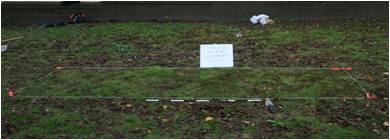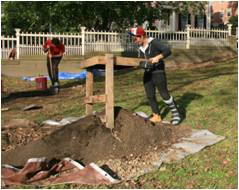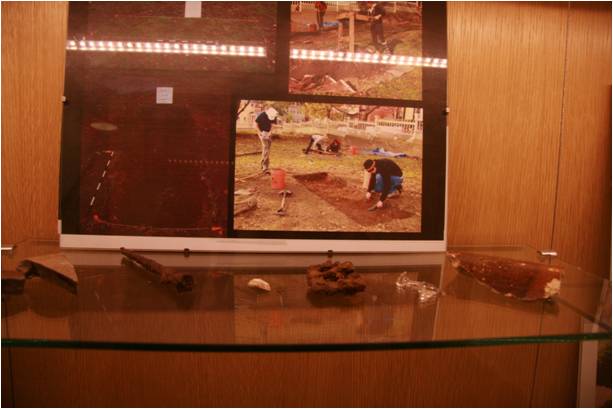Summary of JBH Unit 14:
Here is the panel from the top shelf of the Joukowsky Institute exhibit. This shelf dedicated to the work done at Unit 14. The originalplan for Unit 14 was to excavate a new unit where the fountain was to located. However, after using the total station and geographic inspection to locate the new unit the team found that the fountain was under a bigtree. Due to the location of the fountain, Unit 14 had to look for a new location with the help of the GPR (Ground Penerating Radar). With the GPR results, an anomaly in northwest portion of John Brown House,parallel to Charlesfield Street, was found. The anomaly was detected to be located within 1m deep. So the team opened Unit 14 at this location, where they measured the unit to be 1x3m. They began with their excavation in hopes of discovring a room and/or wall of the Robert Hale Ives House (built sometime between 1834-1857 by Robert Hale Ives and demolished in 1923-1926).
By end of their excavation the team did not find a wall or room but they did found somesort of building foundation, which could be part of the Hale IvesHouse. A skinny rusted metal pipe was found running diagonally from north tosouth of Unit 14. This pipe could have been afflicted with house as it runsbelow or above the foundations.
For more information of this unit, read Unit 13 Summary in the 2011 JBH Site Report.
Images from the Panel


The picture on the left shows the beginning stage of Unit 14 as they officially began in October 3, 2011. The picture on the right shows the final stage of what the unit looked,before we backfilled, at the end of the semester on November 21, 2011. In this picture, we see the contexts and the foundation that was found by the team of Unit 14. By thecomparing these two photos, the progression they have reached by the end of the semester, in such a short amount of time, demonstrates the team's hard work that they had accomplished.


These two pictures shows the excavators of Unit 14 inaction! The picture on the left shows Ian Brownstein, who is seen bagging and labeling finds from their unit, and Brian Kelly using a trowel to deposit the dirt. The picture on the right is Sandra Mastrangelo shown sifting, a technique to remove dirt so any materialsor artifacts are revealed in the sifter.
The Artifacts

From left to right:
Large Stoneware (Unit 14, context 83), Big Nail (Unit 14,context 83), Ceramic with Apple or Chinese Motif (Unit 14, context 80), Metal Buckle(Unit 14, context 83), Bottle Neck (Unit 14, context 76), Large Stoneware (Unit 14, context 88).
For more information of each artifact please read the object biographies done by the excavators of Unit 14, where each student was assignedto chose two artifacts to research upon. The artifacts chosen were due toits uniqueness and interest to the excavators of Unit 14.
